![]()
![]()
![]()
Use LEFT and RIGHT arrow keys to navigate between flashcards;
Use UP and DOWN arrow keys to flip the card;
H to show hint;
A reads text to speech;
45 Cards in this Set
- Front
- Back
|
What are important functions of the BBB in terms of homeostasis? |
- It protects the brain from the external biochemical environment. -It takes up nutrients and other necessary components of brain function. - It discards waste products (hormones, neurotransmitters, etc.) |
|
|
What are the 2 main barrier sites between the blood and the brain, apart from the blood brain barrier (BBB)? |
1. The blood-CSF barrier (BCSFB) 2. The arachnoid barrier |
|
|
Where is the BBB located? |
At the level of the cerebral capillary endothelial cells. The BBB is formed by tight junctions. |
|
|
Where is the BCSFB located? |
It lies in the choroid plexuses in the lateral, third and fourth ventricles of the brain. Tight junctions are formed between the epithelial cells at the CSF-facing surface of the epithelium. |
|
|
Where is the arachnoid barrier located? |
The arachnoid membrane envelopes the entire brain. The arachnoid is a vascular multi-layered epithelium with tight junctions between cells of the inner layer that form an effective seal. |
|
|
What is the function of a pericyte? |
It regulates endothelial cell proliferation, survival, migration, differentiation and vascular branching. |
|
|
What is the function of the basal lamina? |
It provides mechanical support for cell attachment and as such serves as a substrate for cell migration. |
|
|
What is meant by bulk flow? |
It is the flow of fluid in the brain ECF along the capillaries. It is a passive process regarding drug transport. It drains into the CSF. |
|
|
In which part of the brain is the CSF formed? |
In the choroid plexus of the lateral/3rd and 4th ventricles. |
|
|
What is the function of the choroid plexus? |
It produces CSF, it cushions the CNS against trauma, and it removes metabolic waste, drugs and excess neurotrasnmitters. |
|
|
In humans, how can a CSF sample be taken? |
Via a lumbar puncture between the 3rd and 4th lumbar vertebrae. |
|
|
What are the circumventricular organs (CVO)? |
They are midline structures bordering the 3rd and 4th ventricles. They circumvent the BBB. Examples include the pineal gland (melatonin), choroid plexus and pituitary gland (oxytocin and ADH). |
|
|
What are the 4 basic modes of drug transport across the BBB? |
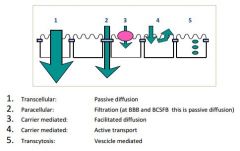
1. Simple diffusion, driven by the concentration gradient (high to low) 2. Facilitated diffusion by a helper molecule (high to low) 3. Fluid phase transport by the vesicles, formed from the membrane by pinocytosis. It requires energy. 4. Active transport through a transporter protein for which the molecule should have a specific binding site. It requires energy and moves against the concentration gradient. |
|
|
What are some factors that affect the passage of a drug across the BBB? |
Lipophilicity, electrical charge, molecular size, dissociation constant, affinity for carrier molecule |
|
|
What does it mean when a drug is at steady state flux? |
In passive diffusion, the rate of diffusion (flux) is proportional to the concentration difference in the unbound drug on either side of the membrane. At equilibrium, the concentration of the diffusing molecules is equal on both sides, and this is called steady state. |
|
|
What are the principles behind passive paracellular diffusion? |
Passive paracellular diffusion occurs when a drug passes through the tight junctions between endothelial cells. Paracellular transport of compounds across an intact BBB is highly limited due to the presence of narrow tight junctions. This mode of transport is size-dependent and permeability limited. |
|
|
What are the principles behind passive transcellular diffusion? |
This is when a drug passes the membrane of endothelial cells in the BBB. Transcellular diffusion of compounds across the BBB depends on lipophilicty and blood flow. The higher the lipophilicity of a drug, the easier it passes the lipid bilayer of the cells. |
|
|
What are the principles behind passive facilitated diffusion? |
It is an energy-independent process facilitated by trans-membrane transport proteins. It is a type of spontaneous transport process. |
|
|
What is pinocytosis? |
It is a form of active transport of compounds across the BBB. It is a means of transport of ECF and its contents in very small vesicles. |
|
|
What is adsorptive-mediated endocytosis (AME)? |
It is a form of active transport that involves endocytosis of charged substances in vesicles. |
|
|
What is receptor-mediated endocytosis (RME)? |
It is a form of active transport whereby substances becoume bound to clathrin in clathrin coated pits. These pinch free from the membrane to form coated vesicles. |
|
|
Name certain factors that cause variability in the BBB. |
Gender, species, tissue, diet, genotype, drug treatment/usage, age, time, disease state. |
|
|
Name some humoral agents that can increase BBB permeability. |
Bradykinin, serotonin, histamine, thrombin, glutamate, interleukins |
|
|
For each part of the BBB, name at least 2 factors that change the BBB permeability: 1. Opening of tight junctions 2. Increased pinocytosis 3. Decreased membrane rigidity 4. Pore formation |
1. Autoimmune encephalitis, multiple sclerosis, inflammation, hyperosmolarity, post-ischaemia reperfusion 2. Acute hypertension, microwave irradiation, ischaemia, seizures, heat stroke, brain unjury, tumours, meningitis 3. Surfactants and solvents (ethanol, propanol, butanol, DMSO) 4. Tricyclic antidepressants (chlorpromazine, nortriptyline) |
|
|
Name the common neurodegenerative components and processes of neurodegenerative disorders. |
Gene defects Oxidative stress Protein misfolding Protein aggregation Cell death |
|
|
Name some problems in CNS drug delivery |
- Half-time of drug is too short in plasma to reach the BBB - May require high dose to reach BBB, but will cause many side-effects - Molecules are too large or hydrophilic to penetrate BBB efficiently - No translation between preclinical models and clinic |
|
|
Define rate, extent and distribution in terms of drugs in the brain |
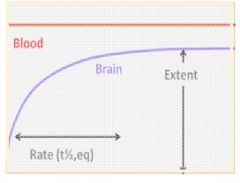
- Extent = How much of the drug can enter the brain - Rate = How fast the drug can be transported (passively or actively) across the BBB into the brain - (Intra-brain) distribution = How much unspecifiec binding there is in the brain in comparison with unbound drug in the brain ECF |
|
|
Define the Kp, Kp,u and Kp,uu |
- Kp = ratio total tissue/total plasma - Kp,u = ratio total tissue/unbound plasma - Kp,uu = ratio unbound tissue/unbound plasma
All 3 are measures of extent of transport, but Kp,uu is the best. |
|
|
What is the Vu,brain? |
It is the unbound volume of distribution in the brain. Volumes <1 ml/g brain indicate restrictions in binding and distribution, while volumes >1 ml/g brain indicate binding |
|
|
According to the model relating molecular structure to brain exposure, an addition of 2 H-bond acceptors to a molecule reduces brain exposure by 50%. What does this mean for drugs? |
- Doubled dose requirement for centrally acting drugs - Doubled safety window for peripherally acting drugs |
|
|
What is PAMPA (parallel artificial membrane permeability assay)? |
It is an in vitro model of passive diffusion whereby the test compound is added to the donor compartment of a 96-well plate. The permeation of compound across an artificial hexadecane membrane is quantified by LC-MS after incubation. |
|
|
What is the TRANSIL brain absorption kit? |
Drugs are incubated with lipid bilayer vesicles which allows for the measurement of drugs that pass the lipid membrane. |
|
|
How can cell cultures be used to measure the BBB? |
When brain cells (BBB endothelial cells, pericytes and astrocytes) are grown onto a membrane, the permeability rate can be measured of a drug. This method is unidirectional so it can only measure influx or efflux. |
|
|
Name some brain tissue sampling techniques for in vivo experiments. |
Brain uptake index (BUI), brain perfusion (BP), IV injection technique, brain efflux index (BEI), quantitative autoradiography. |
|
|
How is the brain uptake index experiment carried out? |
An anesthetized rat or mouse is given a surgically exposed and cannulated left common artery. A 200 ul injection of test compound and reference compound is given after which the brain is removed (5-15 seconds). |
|
|
How is in situ brain perfusion performed? |
An anesthetized rat or mouse with a ligated common carotid artery with cannulation of the external carotid artery is given retrograde perfusion of a test and a reference compound. D-glucose is also added to maintain brain energy supply. After 60-120 seconds the brain is analysed. |
|
|
Describe the IV injection technique for measuring BBB permeability for drugs. |
An anesthetized rat receives an IV bolus injection of a drug. Several arterial blood samples are taken along with brain/CSF samples. This allows for longer experiments (minutes/hours), however, it is limited to just one brain sample per time point. This technique allows for the estimation of BBB kin, kout, Vbr, F and PA. |
|
|
Describe the Brain Efflux Technique for BBB measurement. |
An anesthetized rat is kept in a stereotactic frame. The skull is exposed and a cannula is placed in the cortex region. A test drug and reference compound are injected and brain tisse can be sampled at different times for up to 120 min. |
|
|
How does serial CSF sampling work as an in vivo method? |
A permanent cannula is placed in the brain of a rat in the cisterna magna. The animals can live and move freely with the cannula in place. The CSF is sampled at different time points. |
|
|
What is intracerebral microdialysis? |
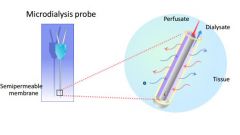
A microdialysis probe is inserted into the brain of a rat. This can sample brain CSF over a long period of time. The technique is similar to the serial CSF sampling technique. |
|
|
Interpret these values: - Kp,uu < 1 - Kp,uu > 1 - Kp, uu = 1
-Vu,brain < 1 - Vu,brain > 1
|
- Low extent, active efflux dominates - High extent, active influx dominates - Passive transport dominates
- Restricted distribution into brain cells - Binding to brain parenchyma and/or intracellular distribution |
|
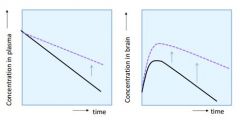
Explain what is happening to shift the continuous line to the dotted line
|
A single i.v. dose is given in both cases, but the dotted line is a case where the clearance in plasma is reduced |
|
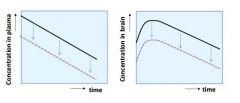
Explain what is happening to shift the continuous line to the dotted line |
In both cases, a single i.v. dose is given. The lines are parallel, therefore, even though there is an increase in plasma clearance, there is also a proportional increase in fu. K does not change! |
|

Label the different coloured lines in the graphs, knowing that the dotted line is an effect of change noted above the figure. |
Red = unbound plasma concentration (Cu,plasma) at steady state Purple = Unbound brain concentration (Cu,brain) for a compound with high permeability Blue = Unbound brain concentration (Cu,brain) for a compound with low permeability |
|
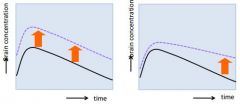
Describe what is happening in both figures |
Figure 1: There is an increase in influx of the drug into the brain Figure 2: There is a decrease in efflux of the drug out of the brain |

